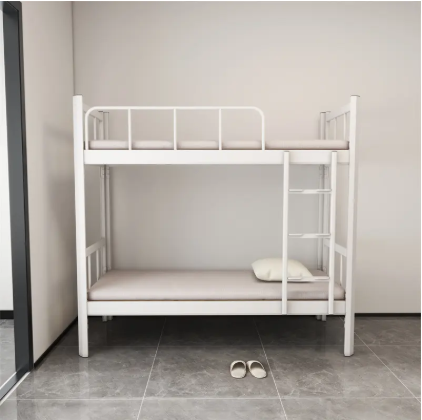Падения с высоты: Предотвращение серьезных травм
Требования к поручням для верхних ярусов
Установка ограждений на верхних ярусах кроватей действительно важна, если мы хотим предотвратить падение детей с кроватей во сне. Правило, согласно которому ограждения должны выступать примерно на семь дюймов над используемым матрасом, также не является случайным руководством. Эксперты в области безопасности, включая Комиссию по безопасности потребительских товаров (CPSC), тщательно изучили этот вопрос, и к какому выводу они пришли? Ограждения довольно эффективно предотвращают падения. Одно конкретное исследование показало, что правильная установка таких ограждений может сократить подобные случаи примерно на тридцать процентов. Существует множество вариантов конструкций: одни остаются на месте постоянно, а другие легко снимаются в зависимости от ежедневного использования кровати. Но самое важное — чтобы выбранная конструкция ограждения действительно хорошо выполняла свою функцию, и родители могли спать спокойно, зная, что их дети не упадут с кровати ночью.
Правильное расположение матраса и предотвращение зазоров
Очень важно, чтобы матрас подходил по размеру и плотно прилегал к краям кровати, иначе могут образоваться щели, в которые могут попасть пальчики ребенка. Если высота матраса не соответствует высоте боковых ограждений, это может создать угрозу безопасности, если ребенок во сне перевернется. Большинство рекомендаций по безопасности советуют выбирать матрасы, которые выступают примерно на шесть дюймов за края кровати, на случай, если положение матраса изменится за ночь. Также разумно регулярно проверять, как матрас установлен, поскольку со временем ткань вытягивается, а пружины проседают. Эксперты по безопасности всегда подчеркивают этот момент, говоря о правильной обстановке спальни для маленьких детей.
Безопасность лестниц и надежные методы подъема
Наличие прочевой лестницы, установленной в правильном положении, действительно важно, когда дети пользуются двухъярусными кроватями, поскольку это помогает предотвратить несчастные случаи при подъеме или спуске. Лестница должна надежно крепиться к каркасу кровати, чтобы не сдвигаться или не отсоединяться. Дети должны держаться за обе стороны лестницы руками и смотреть вперед во время подъема, именно так, как это безопасно делают взрослые. Большинство экспертов по безопасности согласны с этим, и многие сайты для родителей рекомендуют обучать малышей правильной технике лазания с раннего возраста. Когда семьи соблюдают эти основные правила безопасности, дети обычно чувствуют себя намного увереннее, спя на верхних ярусах, и не беспокоятся о том, чтобы получить травму во время вечерних процедур.
Риски застревания: устранение угроз для головы/шеи
Безопасное расстояние между бортиками (меньше 3.5 дюймов)
Правильный подбор расстояния между перилами имеет решающее значение для предотвращения травм головы и шеи у детей. Согласно правилам, расстояние между каркасом кровати и нижней перекладиной не должно превышать 3,5 дюйма, что активно поддерживает Комиссия по безопасности потребительских товаров. Доктор Пол Румелиотис, проработавший десятилетия с маленькими пациентами, часто подчеркивает важность этого зазора, так как ему приходилось видеть слишком много случаев, когда дети застревали и не могли нормально дышать. Родителям необходимо регулярно проверять эти перила, потому что крепежные элементы со временем могут ослабнуть при обычном использовании. Просто убедитесь, что измерения остаются в допустимых пределах, это действительно может снизить количество несчастных случаев, обеспечивая спокойствие семьям, устанавливающим двухъярусные кровати дома главная или в детских садах.
Опасности щелей между стеной и защитные барьеры
Эти пространства между кроватями-чердаками и стенами или мебелью — это не просто раздражающие щели, они действительно опасны для детей, которые могут в них застрять. Маленькие дети особенно склонны пролезать в эти места и застревать там, что может привести к серьезным проблемам, таким как затрудненное дыхание или даже переломы. Родителям стоит подумать об установке защитных ограждений или пенополиуретановых прокладок вдоль этих зазоров, чтобы обеспечить безопасность. Исследования безопасности показывают, что большинство несчастных случаев происходит, когда между рамой кровати и окружающими конструкциями недостаточно места. Однако применение таких защитных мер дает большой эффект, значительно снижая количество происшествий. Большинство экспертов по безопасности детей рекомендуют принять эти дополнительные меры предосторожности семьям, где маленькие дети спят на верхних кроватях.
Соответствие размеров матраса и каркаса кровати для предотвращения застревания тела
Выбор матраса, идеально подходящего по размеру для кровати-яруса, важен не только для комфорта — это действительно важно для предотвращения ситуаций, когда человек может застрять. Если матрас не подходит должным образом, зазоры между краем матраса и рамой могут стать настоящей опасностью. Мы часто сталкиваемся с этим в кроватях, предназначенных для удлиненных матрасов, но в которые устанавливают стандартные по размеру. Исследования неоднократно показывали, что при плотном прилегании матраса к каркасу риск травм значительно снижается. Родителям следует тщательно измерить размеры перед покупкой и периодически проверять их. Простая ошибка в выборе размера матраса может привести к серьезным проблемам у спящих на верхнем ярусе детей.
Проблемы структурной целостности
Закрепленные vs. Отсоединяемые компоненты
Безопасность играет важную роль при использовании двухъярусных кроватей, и знание того, что их удерживает, имеет решающее значение. Споры о болтах против винтов носят не только академический характер. Болты создают гораздо более прочные соединения, что означает меньшую вероятность падения кого-либо из-за ослабления деталей. Большинство специалистов по безопасности скажут родителям, что правильная конструкция наиболее важна для предотвращения травм у детей. Техническое обслуживание также не должно оставаться на заднем плане. Родителям необходимо регулярно проверять точки соединения, особенно в местах, где давление создается весом. Быстрая ежемесячная проверка способна предотвратить множество неприятностей. Обратите внимание на опоры под матрасами и участки крепления лестницы, поскольку износ там происходит быстрее всего.
Пределы веса и регулярные проверки технического обслуживания
Соблюдение ограничений по весу, установленных производителями, имеет большое значение для обеспечения безопасности и устойчивости двухъярусной кровати. Если кто-либо превысит допустимую нагрузку на двухъярусную кровать, ее конструкция может со временем выйти из строя, что, очевидно, повысит вероятность получения травмы. Родителям действительно стоит обращать внимание на технические характеристики, указанные на коробке или в руководстве, а также периодически проводить проверки. Организация простой ежемесячной проверки поможет выявить незначительные проблемы до того, как они превратятся в серьезные угрозы безопасности. Осмотрите нижнюю часть кровати, чтобы обнаружить какие-либо ослабленные или треснувшие планки, правильно затяните все болты и убедитесь, что вся конструкция плотно стоит на полу. Большинство несчастных случаев происходит из-за игнорирования этих базовых шагов, поэтому потратив пять минут в месяц, можно избежать множества проблем в будущем.
Возрастное соответствие использования и надзор
Почему дети младше 6 лет должны избегать верхних ярусов
Дети младше шести лет действительно не должны спать на верхней полке двухъярусной кровати, потому что их координация еще не развита должным образом, да и пространственное восприятие недостаточно хорошее. Маленькие дети просто не понимают, насколько опасно лазить на высокие места или спать на такой высоте. Большинство врачей, специализирующихся на детях, и групп по безопасности по всей стране сходятся во мнении, что это основное правило необходимо соблюдать, поскольку маленькие дети слишком уязвимы, если их размещать на возвышении. Что же могут сделать родители? Многие выбирают альтернативные варианты, которые снижают уровень риска. Выдвижные кровати отлично подходят для маленьких детей, или же можно использовать специальные низкие двухъярусные кровати, специально разработанные для малышей. Такие решения обеспечивают гораздо более безопасные условия сна, позволяя детям постепенно переходить на следующий уровень в соответствии со своим ростом, а не попадать в ситуации, к которым они еще не готовы.
Ночное наблюдение за младшими пользователями
Очень важно обеспечить безопасность детей на двухъярусных кроватях ночью, особенно для тех, кому меньше восьми лет, так как они могут перевернуться во сне или уснуть стоя. Родителям необходимо быть внимательными и установить базовые меры безопасности в доме. Хороший способ — разместить небольшой ночной светильник рядом с кроватью, чтобы ребенок мог без труда добраться до ванной комнаты, не спотыкаясь в темноте. Также отличным решением являются защитные ограждения для кровати, предотвращающие падения, когда дети меняют положение во сне. Мы все не раз видели, как малыши внезапно сбрасывают одеяла или тянутся за игрушками и в результате оказываются на полу внизу. Комбинация простых и здравых мер, подобных этим, поможет сохранить безопасность без постоянного присмотра. Большинство родителей просто хотят, чтобы их дети спокойно спали всю ночь, зная, что они защищены.
Отказ от грубых игр возле кроватей
Игры в грубую игру около коек значительно увеличивают шансы того, что кто-то упадет или получит травму. Дети просто не осознают, какой проблемы они могут натворить, прыгая или борясь рядом с кроватями. Родителям необходимо обучать своих детей не вести себя агрессивно возле мест для сна, если мы хотим, чтобы все оставались в безопасности. Простые правила также творят чудеса — объясните детям, где именно можно играть, и какие игры находятся под запретом. Большинство экспертов в области развития детей скажут нам, что создание безопасных зон для игр играет огромную роль. Они говорят о том, как обучить детей пониманию границ, не подавляя их воображение, чтобы они могли по-прежнему веселиться, но при этом знали свои пределы. Когда семьи организуют такие безопасные зоны вокруг двухъярусных кроватей, они на самом деле формируют более правильные привычки, которые остаются с детьми надолго, даже после окончания сказок на ночь.
Лучшие практики безопасного использования
Ночное освещение для видимости
Организация хорошего освещения у кроватей-ярусов имеет большое значение для обеспечения безопасности всех членов семьи. Детям нужно видеть, куда они идут в темноте, иначе они могут споткнуться или удариться о каркас кровати, находясь в полусне. По моему опыту, лучше всего подходят ночные светильники теплых тонов. Цвета, такие как красный, желтый или оранжевый, создают мягкое, расслабляющее свечение, похожее на закатное, что, как утверждают эксперты по циклам сна, помогает организму понять, что пришло время расслабиться и подготовиться ко сну. Размещение такого светильника рядом с лестницей или на пути, по которому дети идут в ванную, дает ощутимый эффект. Мы установили наш светильник рядом со ступенями и заметили, что количество синяков и ушибов после ночных приключении значительно уменьшилось.
Выбор постельных принадлежностей для снижения риска падений
Выбор правильных комплектующих для сна играет большую роль в обеспечении безопасности детей и предотвращении падений с верхних коек. Использование более тонких матрасов или добавление мягкой набивки по краям значительно снижает риск несчастных случаев, связанных с тем, что ребенок может перевернуться во сне. В настоящее время некоторые компании действительно выпускают специализированное постельное белье, предназначенное конкретно для многоярусных кроватей. Подумайте лишь, сколько родителей, вероятно, ругались, обнаруживая очередную игрушку, застрявшую между простынями! Регулярная стирка всего комплекта — это не только вопрос чистоты. Постельные принадлежности со временем изнашиваются, поэтому базовый уход помогает сохранить их защитные свойства и избежать частой замены.
Подготовка к чрезвычайным ситуациям: Необходимые средства первой помощи
Хранение хорошей аптечки первой помощи рядом делает все по-другому, когда речь идет о травмах от неизбежных происшествий на двухъярусных кроватях. Основные средства должны охватывать все, от простых ссадин до более серьезных ранений: подумайте об адгезивных повязках различных размеров, антисептических салфетках для очистки ран, пакетах со льдом для уменьшения отека и, возможно, даже безрецептурных обезболивающих средствах. Не забудьте и о мелочах, таких как пара стерильных пинцетов для удаления заноз или осколков стекла после падения. Родители также действительно должны пройти хотя бы один базовый курс первой помощи. Эти курсы преподают практические навыки, которые выходят за рамки простого чтения инструкций на упаковке. Когда человек знает, что делать во время чрезвычайной ситуации, он действует быстрее и лучше. Подготовка дает семьям уверенность и помогает избежать превращения ночных происшествий в более серьезные проблемы.
Раздел часто задаваемых вопросов
Какие основные требования к поручням на двухъярусных кроватях?
Перила безопасности должны выступать как минимум на семь дюймов над матрасом. Их установка значительно снижает количество падений, согласно исследованиям по безопасности.
Как обеспечить безопасность лестницы для двухъярусных кроватей?
Лестница должна быть надежно закреплена к кровати, и детей нужно научить подниматься, держась обеими руками и глядя на лестницу, чтобы предотвратить падения.
Какое расстояние считается безопасным для перил, чтобы предотвратить застревание головы/шеи?
Пространство между каркасом кровати и перилами не должно превышать 3,5 дюйма, как рекомендуется для предотвращения рисков застревания.
Почему детям младше 6 лет следует избегать верхних铺?
Детям младше шести лет следует избегать верхних铺 из-за их возрастных особенностей, включая недостаточно развитую координацию и пространственную осведомленность.


